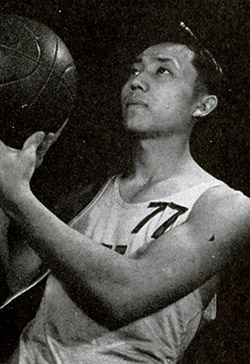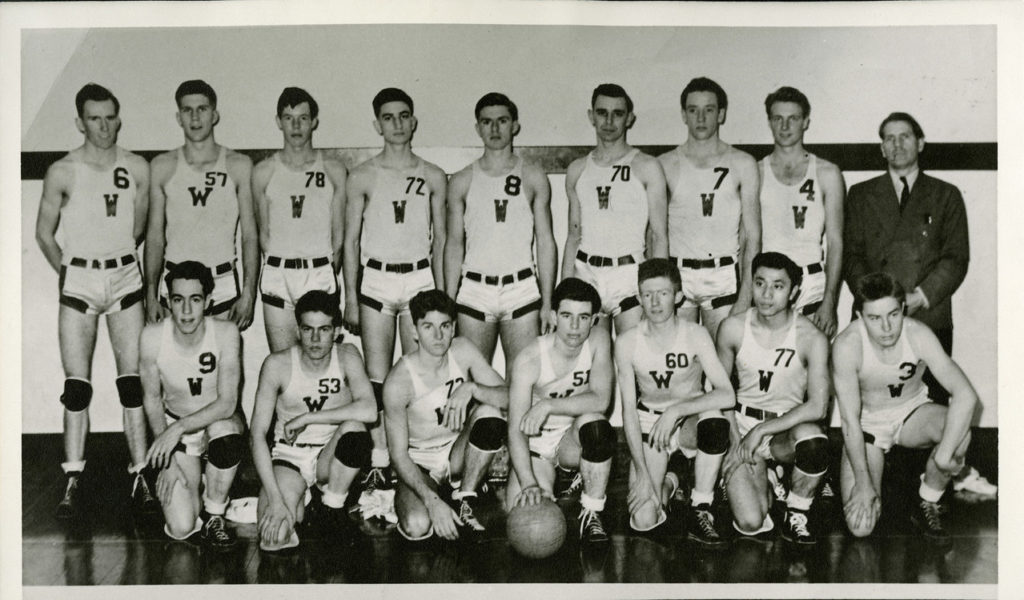
Wataru Misaka, Weber State University alumnus and first non-white player in the Basketball Association of America (BAA), returned to his alma mater for the screening of “Transcending – The Wat Misaka Story” on Nov. 7 in the Lindquist Alumni Center.
Weber State University Archives co-sponsored the event with Alumni Relations.
“Transcending” follows the trajectory of Misaka’s life, centering around basketball. The film includes interviews with Misaka, his family, previous teammates and sports aficionados.
Misaka was born and raised in Ogden under the roof of Japanese-born immigrants. He attended then-named Weber Junior College, leading Wildcats to the Intermountain Collegiate Athletics Conference (ICAC) championship in 1942 and 1943.

Beyond basketball, Misaka was involved in the track team, he was secretary of the Wildcat Club and he earned his associate of science degree, graduating with high honors.
After serving two years in the U.S. Army, Misaka was selected as the first draft pick for the New York Knicks in 1947. Misaka was drafted to the Knicks despite the anti-Japanese sentiment during World War II, in part because of his performances at tournaments in Madison Square Garden.
The film drew attention to Misaka’s special brand of play. In his collegiate years, players sat on the court and couldn’t talk to their coach during timeouts. Players during this era needed a leader on the court, and Misaka played that role at the collegiate level.
“Transcending” directors Bruce Alan Johnson and Christine Toy Johnson learned about Misaka while sitting in Paul Osaki’s office in 2006. Osaki worked for the Japanese Cultural and Community Center of Northern California.
“Paul told us (Misaka’s) story, and we were just immediately drawn to it. We thought that story is not known widely enough, and we want to make sure it is,” Christine Johnson said.
Osaki contacted Misaka’s wife, Katie Misaka. She acted as a liason between the directors and her husband.
“Wat’s reply was ‘Well it’s no big deal. Nobody outside the state of Utah really cares, but if you want to come talk to us you can’,” Bruce Johnson said about his initial call with Misaka.
Misaka’s professional career with the Knicks lasted three games, totaling seven points. He returned to Utah to earn his degree and work as an engineer. Despite his short-lived career in the precursor league to the NBA, Misaka remains the first person of color drafted into the BAA, a claim not universally accepted.
Bruce and Christine Johnson didn’t think calling Misaka “the first person of color in the NBA” would be met with push back, but it was. Christine Johnson credited this to discussion of race in the U.S. being polarizing.
Christian Phomsouvanh, WSU junior and president of the Asian Students Involvement Association, said the event was an opportunity to not only learn about WSU history, but also about ethnic minorities.
“I think it’s important for a lot of multicultural groups and ethnic minorities to be proud of who they are and celebrate things like this because he has so many great accomplishments, and I feel like not a lot of people know who he is or what he’s done,” Phomsouvanh said.
While Misaka is not a household name like Jackie Robinson, and although he believes only Utahns would care about his story, he has begun to receive recognition for what he accomplished.
He was inducted into the Utah Sports Hall of Fame in 1999 and into the Weber State Athletics Hall of Fame in 2011. President Barack Obama welcomed Misaka to the White House in 2009. During the summer, Ogden named a newly resurfaced public court at Liberty Park the “Kilowatt Court” after Misaka’s nickname.




















